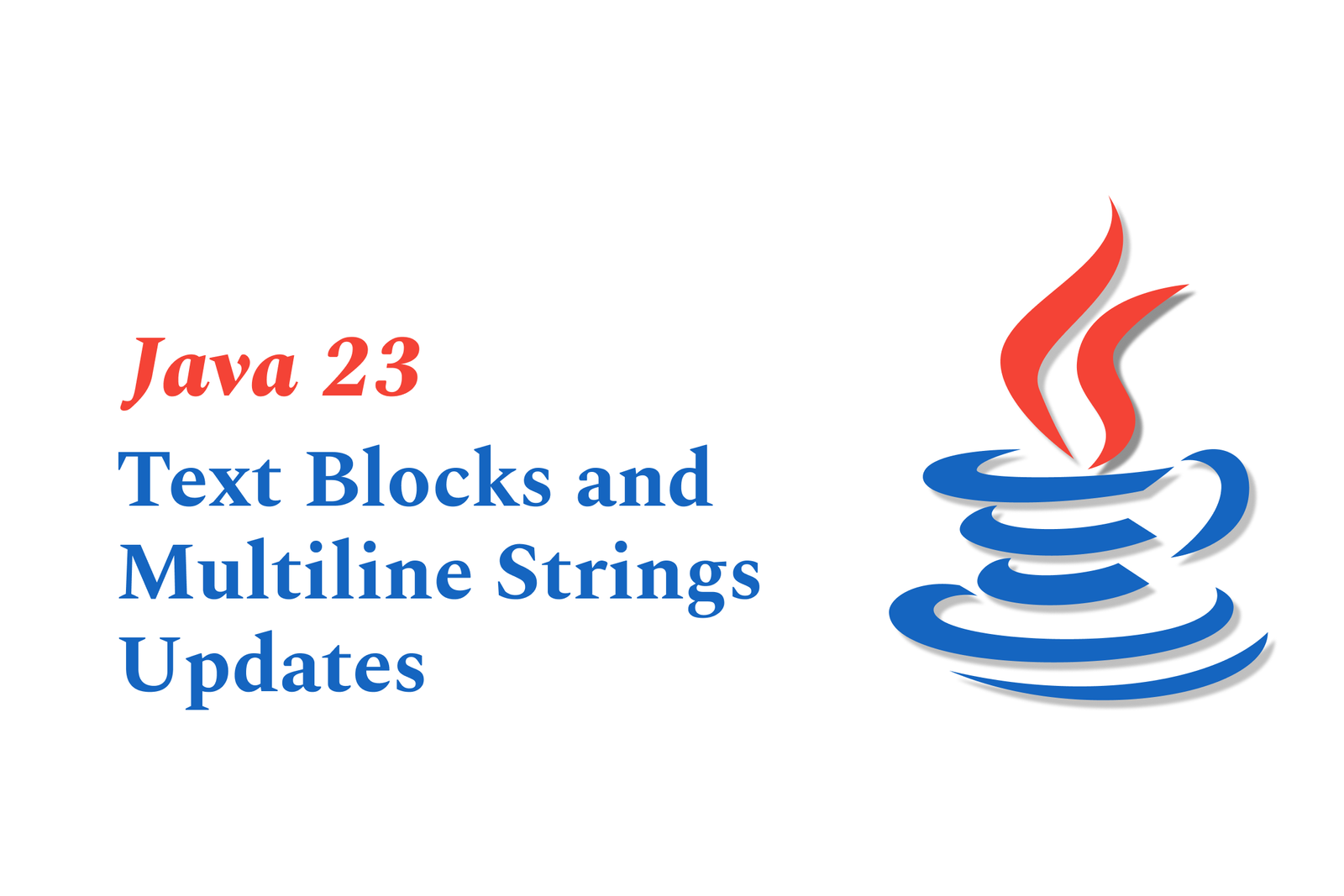Java 23 Text Blocks And Multiline Strings Updates
Java 23 enhances text blocks and multiline strings, improving whitespace control, escape sequence handling, and integration with formatting methods. This update makes writing readable, maintainable multiline strings in Java easier and more flexible than ever before.
Java 23 Text Blocks and Multiline Strings Updates
1 ) Introduction to Text Blocks in Java
Text blocks are a language feature introduced to simplify the expression of multiline strings.
Traditional multiline strings in Java required escape sequences, concatenations, and clutters of delimiters.
Text blocks allow embedding multiline text and code snippets clearly and more naturally.
They produce objects of type `java.lang.String`, identical in behavior to traditional string literals, including interning properties.
2 ) Syntax and Usage of Text Blocks
A text block starts with three double quotes (`"""`) followed by a mandatory newline; single line text blocks without an initial newline are invalid.
The content inside a text block is enclosed preserving the line structure, which improves readability vastly compared to legacy concatenation with `\n` and quotes.
Text blocks can be seamlessly used wherever string literals are accepted: variable assignment, method arguments, expressions, and concatenations with other strings.
3 ) Advantages Over Traditional String Literals
Eliminates clutter from escape sequences (like `\n`, `\"`), quotes, and concatenation operators.
Preserves text layout (line breaks and indentation) as intended, especially useful for embedding code (HTML, SQL, JSON).
Improves maintainability and legibility of code handling embedded multiline content.
4 ) Control Over White Space and Newlines
Text blocks offer mechanisms to control incidental white spaces, trailing spaces, and explicit newlines.
Developers have options to normalize line terminators and interpret escape sequences to fine tune the exact output string.
Style guidelines recommend consistent indentation and usage patterns to maximize clarity.
5 ) Integration With Existing String APIs
Text blocks fully support all standard `String` methods (`substring`, `equals`, etc.).
New utility methods like `String.stripIndent()` and `String.translateEscapes()` assist in managing white space and escape sequences effectively.
The `String.formatted(Object… args)` method aids in formatting strings, which complements text blocks by enabling formatted multiline strings, addressing some interpolation like use cases.
6 ) Historical Development Context
Text blocks evolved from earlier JEPs focused on improving raw string literals.
Previewed incrementally in Java 13 and 14 as JEP 355 and JEP 368 respectively, with refinements such as additional escape sequences.
Declared a final permanent feature in Java 15 via JEP 378, balancing simplicity, readability, and backward compatibility with traditional string literals.
7 ) Common Use Cases
Embedding HTML, XML, SQL, JSON or other code in Java source without cumbersome escapes.
Writing long formatted messages or text that spans multiple lines.
Improving readability of configuration or template strings.
8 ) Best Practices
Always start a text block with a newline for clarity and proper indentation support.
Utilize `stripIndent()` when you want to remove incidental white space efficiently.
Use `translateEscapes()` to allow escape sequences handling inside text blocks.
Combine text blocks with `String.formatted()` for improved formatting and readability.
Summary:
The Java 23 update further enhances text blocks by refining multiline string handling, expanding control over whitespaces, and optimizing integration with string formatting methods. This feature empowers developers to write clearer, more maintainable, and visually clean multiline string literals, dramatically improving how Java code represents embedded text and code snippets.
https://justacademy.in/news-detail/how-react-native-is-powering-the-next-wave-of-social-apps
https://justacademy.in/news-detail/flutter-for-smart-tvs-and-iot
https://justacademy.in/news-detail/java-vs-python-in-2025:-which-one-should-you-learn?
https://justacademy.in/news-detail/flutter-ux-design-tips-in-2025
https://justacademy.in/news-detail/new-android-security-updates-and-patches
Related Posts
In 2025, top Angular libraries offer modern, feature-rich components and tools for building dynamic web apps. From powerful data grids to low-code platforms like UI Bakery, these libraries enhance development speed, UI design, and scalability, making them essential for Angular developers.
Migrating from AngularJS to Angular 17 involves gradually upgrading your app by running both frameworks together using tools like ngUpgrade, rewriting components in TypeScript, and adopting Angular’s modern architecture to enhance performance, maintainability, and long-term support.
Angular state management tools help organize and handle app data efficiently, improving scalability and maintainability. Popular options include NgRx for robust, RxJS-based patterns, and newer Signal Store solutions that offer simpler, reactive approaches integrated tightly with Angular’s latest features.
RxJS in Angular empowers developers to manage asynchronous data streams with powerful operators like `forkJoin`, `combineLatest`, and `zip`. Mastering these key operators in 2025 is essential for building efficient, reactive applications that handle complex event sequences seamlessly.
Angular performance optimization in 2025 focuses on improving app speed and responsiveness by using techniques like OnPush change detection, lazy loading, efficient data caching, and AOT compilation. These practices reduce load times, enhance user experience, and ensure scalable, fast Angular applications.
In 2025, Angular remains preferred for large-scale, enterprise apps with its robust, all-in-one framework, while Vue attracts developers seeking simplicity and fast development for smaller projects. Both frameworks excel, with choice driven by project needs and team expertise.
Angular Signals are a new reactive primitive in Angular 16 that enable fine-grained, efficient change detection by automatically tracking dependencies and updating only affected parts of the UI. They simplify state management and boost app performance, revolutionizing Angular's reactivity model.
Angular interview questions to prepare in 2025 focus on core concepts like components, directives, data binding, routing, and dependency injection, along with TypeScript mastery and latest Angular features to ensure strong practical knowledge for building scalable, efficient web applications.
AngularJS reached its official end of support in January 2022, meaning no further updates or security patches. To ensure app security and performance, developers should consider migrating to modern Angular versions or seek third-party long-term support options if immediate migration isn’t possible.
The Angular Roadmap 2025 highlights upcoming features focused on improving developer experience and performance, including zoneless Angular, Signals integration, enhanced Forms, async data handling, improved HMR, and expanded Angular Material/CDK enhancements, driving modern, efficient web app development.










